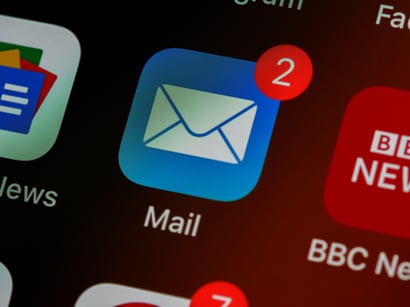
You've got your Marketing strategy all laid out and set up: content creation, landing pages, CTAs, and forms...But somehow, the Sales side of things never seems to see the full results. That's because in order to realize the true potential of Marketing, your Sales team needs to be onboard. This is called Marketing and Sales Alignment.
You already know HubSpot is the ultimate platform for Inbound Marketing...but how can you improve your Marketing with the HubSpot Sales Hub? Find out below!
What is Marketing and Sales Alignment?
Simply put, alignment between marketing and sales is really about focusing on the customer -- and the customer's buying behavior has changed significantly. Fortunately, the better you can align your sales and marketing teams, the more likely you are to delight a prospect. To truly delight your customer, it's critical you reduce friction by implementing a strategy to align your sales and marketing teams. - HubSpot
As stated above, Marketing and Sales Alignment is all about reducing friction for customers, and that means meeting with both departments, hashing out content and objectives together, and defining a combined strategy for Inbound.
Why is Marketing and Sales Alignment important?
The biggest mistake that companies make is thinking that Marketing and Sales departments are separate. In fact, according to HubSpot, companies with good smarketing [sales and marketing] practices in place generated208% more revenuefrom marketing efforts. Simply put, Sales needs to be involved and onboard with what Marketing is doing, and Marketing needs to understand the pitches, pains, and KPIs of the Sales team.
Need more proof that these two teams need to work together? Below, discover the 5 most convincing statistics on the subject:
- Misalignment between sales and marketing costs B2B companies 10% or more of revenue loss annually (HubSpot)
- 71% of buyersconduct their own research and contact sales reps over the phone or chat only when needed (Accenture)
- 60-70% of B2B content created is never used. In many cases, this is because the topic is irrelevant to the buyer audience (Content Marketing Institute)
- Companies with strong sales and marketing alignment achieve a 20% annual growth rate (Aberdeen)
- Organizations with tightly aligned sales and marketing functions enjoy 36% higher customer retention rates (Marketing Profs)
How can the HubSpot Sales Hub help your Inbound Marketing strategy?
Now that you've seen the evidence behind why Sales and Marketing must be on the same page, how do you get Sales up to speed? If you've already got your Marketing strategy set up and you're considering the HubSpot Sales Hub to take it to the next level, discover the ways that you can achieve Marketing and Sales Alignment through the platform:
1. Understand Buyers
As mentioned constantly in the Inbound Marketing methodology, understanding your buyers is crucial to attracting the right people with Marketing, and closing relevant and quality leads with Sales. According to MarketingSherpa, just 56% of B2B organizations verify valid business leads before they are passed to sales. In fact, this causes sales reps to ignore 50% of Marketing leads and waste lots of time doing unproductive prospecting. To make sure you're targeting the right people, develop Buyer Personas with input from Sales data and Sales agents themselves.
Once you've developed your Personas, you may find the need to update your Marketing and Sales cycles, often called the Buyer's Journey. According to HubSpot, 95% of shoppers choose a company that provides them with content through every step of their buyer journey. If you're searching for information on what each stage of the Buyer's Journey means for Marketing and Sales, we offer this quick guide. Furthermore, discover the most valuable content types for each stage.

2. Consistent Messaging
A frustration that many customers go through is a disconnect between Marketing and Sales in terms of messaging, offers, and even timelines. You don't want to build up customer expectations in Marketing content, only to change or fall through in the Sales funnel. What's more, Kapost reports that 65% of sales reps say they can't find content to send to prospects.
Playbooks and snippets can be developed together to create consistent messages, stay on brand, and always follow through on promises.
- Playbooks:Playbooks allow you to build and access content in HubSpot like call scripts, battle cards, documents, etc.
- Snippets:Snippets are pre-defined texts for writing emails. Now, you won't have to remember what messages and offers are on the table; build them out with the Marketing team and easily add them to your follow-up emails. Use the proper personalization tokens and links to relevant content.
3. Lead Nurturing
 Lead nurturing is a process by which you understand more about your prospects, sending them more and more relevant information to help them in their search and final decision. Lead nurturing needs to be timely, consistent, and personalized. According to Annuitas, 47% larger purchases result from nurtured leads than non-nurtured leads.
Lead nurturing is a process by which you understand more about your prospects, sending them more and more relevant information to help them in their search and final decision. Lead nurturing needs to be timely, consistent, and personalized. According to Annuitas, 47% larger purchases result from nurtured leads than non-nurtured leads.
The Sales Hub lets your Marketing department take control of email communications for Sales, so your agents can nurture leads with proper content. What's more, you can build tasks and queues so agents know what to do next and have built-in automation. Deal pipelines let you rotate leads, and if you've implemented a chatbot or live chat, the Sales Hub gives you the ability to assign chats directly to agents.
HubSpot templates and sequences make nurturing easy:
- Templates: Like snippets, templates are pre-built emails that can be developed and sent out to leads in your sequences (see below).
- Sequences: Sequences are the sales version of an email nurturing cycle, with timed emails and tasks to nurture and follow up with your SQLs.
4. Timely Follow-Up
There's no doubt you've witnessed this: customers frequently getting back in touch via forms if they don't get a timely answer. Even worse, they might not return at all due to frustration! With all the work Marketing has done to attract and convert leads, you don't want the Sales funnel to cause friction.
Document tracking and email tracking from the Sales Hub will let your agents know exactly when a document or email has been opened by your prospect, so they can move onto the next phase of the nurturing process - or close the sale! The average lead response time is around 40 hours, but 35-50% of sales go to businesses that respond much quicker (HubSpot recommends 10 minutes). To help with this, there are two HubSpot tools: the Deal pipeline and Quotes, which help you efficiently track and close sales.
By observing your prospects more closely, you'll see that a lot more of your leads are closing. And you'll be able to more easily pinpoint the problems in the Marketing and Sales cycle for the leads that don't end up converting...but it won't be because you weren't attentive enough! According to Forrester, 46% of marketers with mature lead management processes have sales teams that follow up on more than 75% of marketing-generated leads.
5. Common KPIs
It's often difficult deciding on the objectives and goals of your organization, especially between different teams. However, this is one of the most crucial elements for optimizing both your Marketing and Sales teams. According to Act-On, 56% of aligned companies meet their revenue goals. Furthermore, an additional 19% manage to beat their targets. The KPIs you'll want to focus on for smarketing alignment are:
- Sales cycle length: Observe how long the sales cycle takes, where your leads are getting held up, and the resources used at each point. You want your sales cycle to be as quick as possible, because that will mean you leads are properly nurtured or qualified.
- Sales funnel ratios (MQLs, SQLs, customers): First of all, you need to define what constitutes a Marketing qualified lead (MQL) and Sales qualified lead (SQL). Then figure out, how often do MQLs become SQLs? What percentage of SQLs convert into customers? Knowing this data can help you calculate how many leads you need to attract to hit your targets.
- Account size and revenue:You want to focus your efforts on high-value leads. Perform a deep-dive into the accounts that have closed, their timelines, content consumption, etc. and extract conclusions to inform your choices for targeting new accounts.
- Content spend and usage:You need to identify which content is relevant to leads, and what's not. Mis-aligned content is a huge problem in Marketing. Study which pieces are being used by sales and which have traffic/downloads. Focus your efforts only on the high-performing content.
- ROI of the project:As always, you need to evaluate the ROI of the project to make sure you're using the best strategy and that your vision is properly aligned with your goals.
More about the HubSpot Sales Hub
If you're a Marketing leader who needs to show strong growth for your business, the Sales Hub is the perfect addition to your Marketing tool set. This software easily links the Marketing and Sales (and even Service) departments on one single platform. Its easy-to-use tools function across departments and you'll easily be able to extract value - and data - from your actions.
The HubSpot Sales Hub comes in four packages: Free, Starter, Professional, and Enterprise, and you will benefit from a single CRM for seamless data updating. Discover more about everything that the HubSpot Sales software can do.
HubSpot Marketing in combination with Sales Hub features can make both your Marketing and Sales strategies soar! The fact is, true Inbound success always combines these two branches. If you're looking to expand your strategy within HubSpot, and you're looking for a HubSpot Partner Agency to define the next steps, get in touch with mbudo.

Mary Swick
Mary is a professional copywriter with over 10 years of experience in Marketing and Advertising. As an American expat in Madrid, she enjoys the relaxed Spanish culture, hiking, and the latest shows from Netflix and HBO. Mary also loves cats and music (she's the office DJ!)
It may interest you
LATEST
BLOG POSTS
SUBSCRIBE TO MBUDO BLOG
And get your inbound news directly in
your inbox, once a month.


